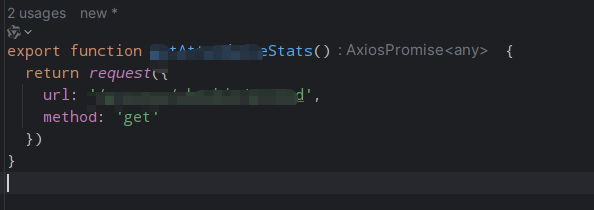【SpringBoot】20 - SpringBoot中的Ajax和MyBatis究竟是什么?
文章目录
前言
在现代Web开发中,前后端分离架构已经成为主流。Spring Boot作为后端开发的热门框架,常与前端技术Ajax和持久层框架MyBatis配合使用,构建高效、灵活的Web应用。那么,Ajax和MyBatis在Spring Boot项目中究竟是什么角色?它们如何协同工作?本文将带你深入理解它们的本质与协作流程。
一、Ajax:前端的异步通信引擎
1、Ajax 是什么?
Ajax(Asynchronous JavaScript and XML)是一种前端技术,用于在不刷新整个页面的情况下,与服务器进行异步数据交互。它使得网页能够动态更新内容,提升用户体验。
虽然名字中有“XML”,但现代开发中更多使用 JSON 格式传输数据。Ajax 的核心是通过 JavaScript 发起 HTTP 请求,获取数据后局部更新页面。
2、Ajax 在 Spring Boot 前端中的体现
在基于 Vue、React 等前端框架的 Spring Boot 项目中,Ajax 通常通过 axios 或 fetch 等库封装实现。
例如,在 Vue 中调用后端接口:
axios.get(\'/api/attendance/stats\') .then(response => { console.log(response.data); });前端接口:

或者使用封装的方法:
D.getAttendanceStats().then(response => { attendPersonnel.value = response.data.attendCount; totalPersonnel.value = response.data.totalCount;});这里的 D.getAttendanceStats() 本质上就是封装了一个 Ajax 请求,向 Spring Boot 后端发送 GET 请求,获取出勤统计数据。
后端controller体现:

3、Ajax 的作用总结
- 异步通信:无需刷新页面即可获取数据。
- 动态更新:根据返回数据动态更新页面内容。
- 前后端解耦:前端通过 API 与后端交互,不依赖服务器端渲染。
✅ 简单说:Ajax 是前端向后端“要数据”的工具。
二、MyBatis:后端的数据库桥梁
1、MyBatis 是什么?
MyBatis 是一个优秀的持久层框架,它简化了 Java 应用与数据库的交互。它通过 XML 或注解的方式,将 SQL 语句与 Java 方法进行映射,避免了传统 JDBC 的繁琐代码。
MyBatis 的核心思想是:让开发者专注于 SQL,而不是数据库连接和结果集处理。
2、MyBatis 在 Spring Boot 后端中的体现
在 Spring Boot 项目中,MyBatis 通常与 Spring Boot Starter MyBatis 集成,通过以下几层协作完成数据库操作:
(1)Controller 层:接收前端请求
@RestController@RequestMapping(\"/api\")public class AttendanceController { @Autowired private AttendanceService attendanceService; @GetMapping(\"/attendance/stats\") public Result getAttendanceStats() { Map<String, Object> stats = attendanceService.getAttendanceStats(); return Result.success(stats); }}Controller 接收来自前端的 Ajax 请求,调用 Service 层处理业务逻辑。
(2)Service 层:处理业务逻辑
@Servicepublic class AttendanceService { @Autowired private AttendanceMapper attendanceMapper; public Map<String, Object> getAttendanceStats() { return attendanceMapper.selectStats(); }}Service 层负责协调数据获取,调用 MyBatis 的 Mapper 接口。
(3)Mapper 层:MyBatis 的核心接口
@Mapperpublic interface AttendanceMapper { Map<String, Object> selectStats();}这是一个接口,MyBatis 会根据方法名找到对应的 SQL 语句。
(4)SQL 映射:定义数据库查询
<select id=\"selectStats\" resultType=\"map\"> SELECT COUNT(*) AS totalCount, SUM(CASE WHEN status = \'PRESENT\' THEN 1 ELSE 0 END) AS attendCount, MAX(checkin_time) AS latestDate FROM attendance_record</select>MyBatis 将这条 SQL 的执行结果自动映射为 Java 的
Map对象,返回给前端。
3、MyBatis 的作用总结
- SQL 映射:将 Java 方法与 SQL 语句绑定。
- 结果映射:自动将数据库记录转换为 Java 对象。
- 简化开发:无需手动处理 Connection、Statement、ResultSet。
✅ 简单说:MyBatis 是后端从数据库“查数据”的桥梁。
三、Ajax 与 MyBatis 的协作流程
Ajax 和 MyBatis 虽然分别位于前后端,但它们通过 HTTP API 紧密协作,完成数据的完整流转。以下是典型的数据请求流程:
用户浏览器(前端) ↓[Vue 页面] → 调用 D.getAttendanceStats() ↓Ajax 发起请求 → GET /api/attendance/stats ↓Spring Boot 后端 Controller 接收请求 ↓Controller 调用 Service 层 ↓Service 调用 MyBatis Mapper ↓MyBatis 执行 SQL 查询数据库 ↓数据库返回数据(如 totalCount=28, attendCount=20) ↓MyBatis 将结果映射为 Java Map ↓后端返回 JSON 响应:{ \"code\": 200, \"data\": { ... } } ↓Ajax 收到响应,执行 .then() 回调 ↓Vue 更新页面数据:attendPersonnel.value = response.data.attendCount ↓页面动态显示最新出勤信息 ✅四、总结
- Ajax 是前端的“手”,负责发起请求、获取数据。
- MyBatis 是后端的“脚”,负责连接数据库、查询数据。
- 它们通过 RESTful API 连接,共同实现前后端数据交互。
在 Spring Boot 项目中,理解 Ajax 和 MyBatis 的分工与协作,是掌握全栈开发的关键一步。只有前后端高效配合,才能构建出响应迅速、体验流畅的现代 Web 应用。


